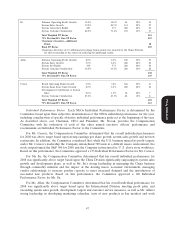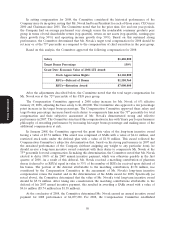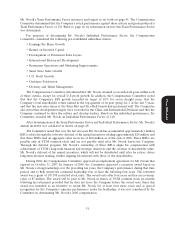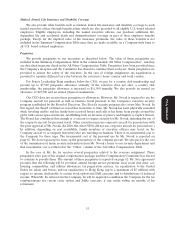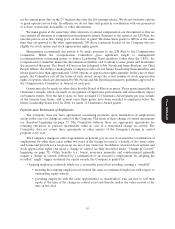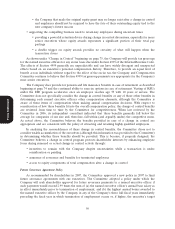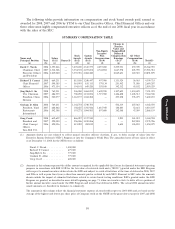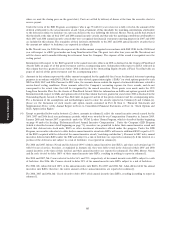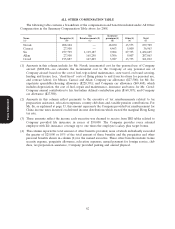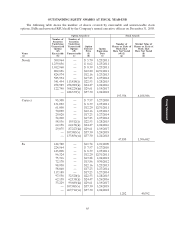Pizza Hut 2008 Annual Report Download - page 75
Download and view the complete annual report
Please find page 75 of the 2008 Pizza Hut annual report below. You can navigate through the pages in the report by either clicking on the pages listed below, or by using the keyword search tool below to find specific information within the annual report.
23MAR200920295069
bonus. Certain types of payments are excluded from this policy, such as amounts payable under
arrangements that apply to classes of employees other than the named executive officers or that predate
the implementation of the policy, as well as any payment that the Committee determines is a reasonable
settlement of a claim that could be made by the named executive officer.
Recoupment Policy
In 2009, the Compensation Committee adopted a Compensation Recovery Policy for stock awards
and annual incentives awarded after 2008. Pursuant to this policy, executive officers (including the NEOs)
may be required to return compensation paid based on financial results that were later restated. This
policy applies only if the executive officers engaged in knowing misconduct that contributed to the need for
a material restatement, or contributed to the use of inaccurate metrics in the calculation of incentive
compensation. Under this policy, when the Board determines in its sole discretion that recovery of
compensation was appropriate, the Company could require repayment of all or a portion of any bonus,
incentive payment, equity-based award or other compensation, to the fullest extent permitted by law.
Deductibility of Executive Compensation
This provision of Section 162(m) of the Internal Revenue Code limits the tax deduction for
compensation in excess of one million dollars paid to certain executive officers. However, performance-
based compensation is excluded from the limit so long as it meets certain requirements. The
Compensation Committee believes that the annual incentive awards and stock option and stock
appreciation rights grants satisfy the requirements for exemption under the Internal Revenue Code
Section 162(m). Payments made under these plans qualify as performance-based compensation.
For 2008, the annual salary paid to Mr. Novak exceeded one million dollars. The Compensation
Committee sets Mr. Novak’s salary as described above under the heading ‘‘Compensation of Our Chief
Executive Officer.’’ The other named executive officers were in each case paid salaries of less than one
million dollars. The 2008 annual incentives were all paid pursuant to our annual incentive program and
will, therefore, be deductible. In this regard, the Compensation Committee exercises ‘‘negative discretion’’
in setting payouts under the annual incentive plan. By setting a high amount which can then be reduced at
Proxy Statement
the Committee’s discretion, our annual incentive plan meets the requirements of Section 162(m) of the
Internal Revenue Code. In 2008, the Compensation Committee, after certifying that EPS had exceeded the
10% growth target which would permit a maximum payout, exercised its negative discretion to reduce the
payout to the CEO from $6.0 million to $4.06 million. As discussed beginning at page 50, this reduction
was not a negative reflection on the CEO’s performance as he, in fact, performed significantly above
expectations (for example, EPS growth was 14%). While the Compensation Committee does utilize
‘‘negative discretion’’ from a tax perspective, the Committee administers the plan, in particular with the
setting of objective performance criteria as discussed beginning at page 45, as if the annual incentive plan
was a non-discretionary plan. For example, if a performance measure is not attained at a certain level, no
bonus will be paid.
To the extent any of the named executive officers defer their annual incentives into phantom shares of
YUM common stock and receive a matching contribution, the annual incentives are no longer qualified
under Section 162(m). However, we expect incentives will be deductible when paid because they will be
paid only at a time when they will otherwise represent deductible compensation, such as payments made
when the executive is no longer a named executive officer. Due to the Company’s focus on performance-
based compensation plans and the deferral of compensation by certain executive officers, we expect to
continue to qualify most compensation paid to the named executive officers as tax deductible.
57


